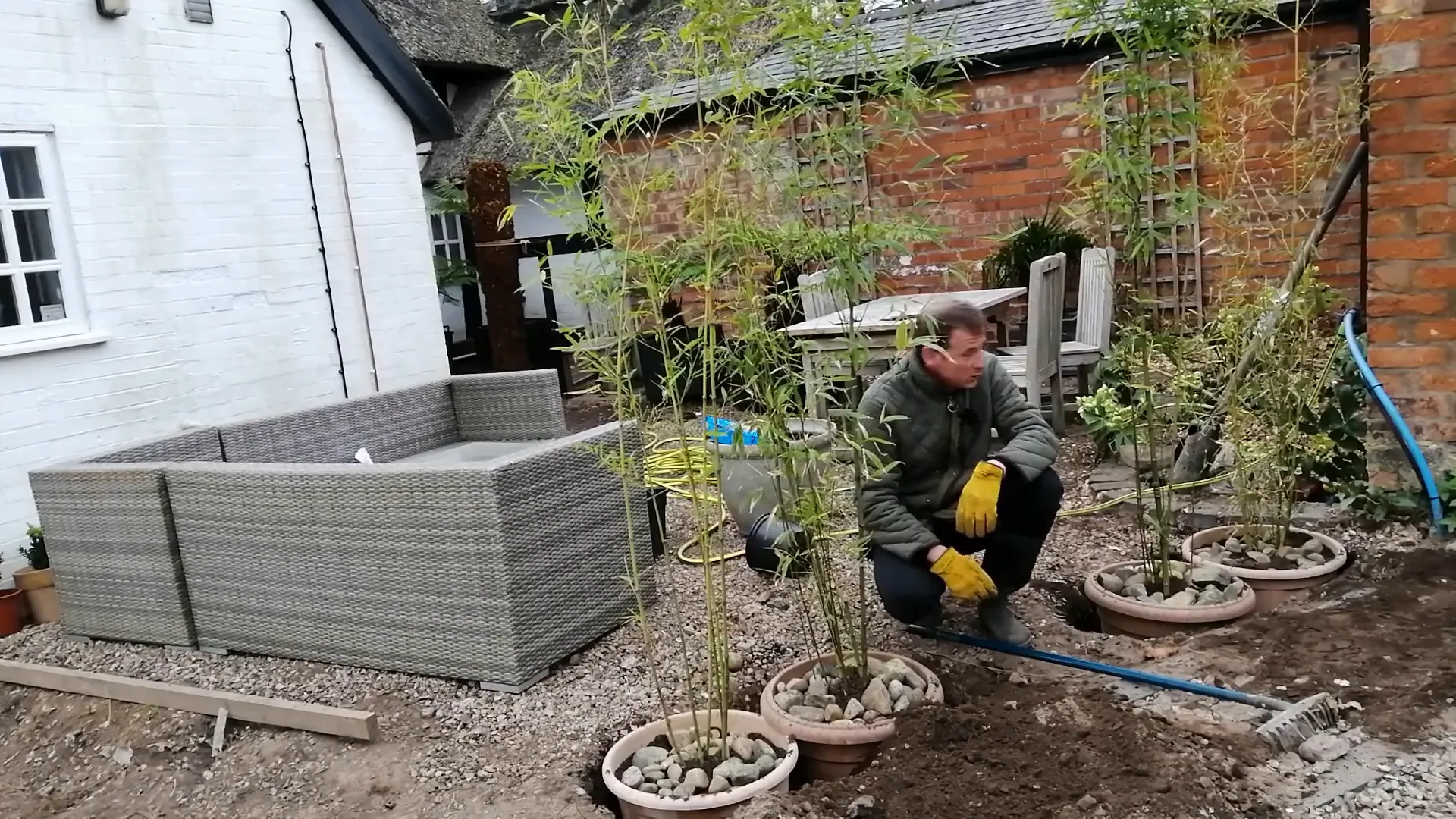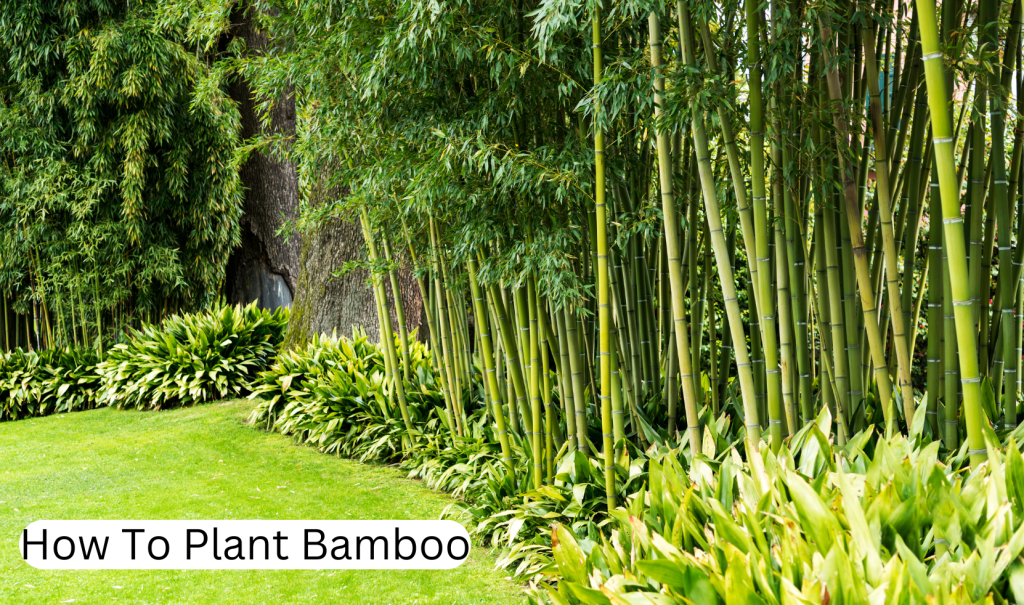If you want to improve your garden’s privacy and beauty, discovering how to plant bamboo can make a difference. This guide will walk you through the process of planting bamboo while also discussing factors to manage its growth.
Table of Contents
- Introduction to Bamboo Planting
- Mixing Soil and Compost for Optimal Growth
- Orienting Bamboo for Maximum Privacy
- Final Steps and Backfilling
- FAQs About Planting Bamboo
Introduction on How to Grow Bamboo
Bamboo isn’t a mere plant; it’s a flexible element that can turn your garden into a peaceful retreat. To grow bamboo successfully it’s important to understand the species, planting methods and care routines. By selecting the bamboo variety you can appreciate its charm while managing its growth.
Choosing the Right Bamboo Species
When it comes to planting bamboo choosing the species is essential. Different types of bamboo have growth rates, heights and levels of invasiveness. For example the bamboo can grow tall in just one season.
- Clumping Bamboo: This type grows in tight clusters and is less invasive. It’s ideal for smaller gardens.
- Running Bamboo: Known for its aggressive growth, this species can spread rapidly. It requires careful management to prevent unwanted expansion.
- Fast Growing Bamboo Species: Species like Phyllostachys edulis can grow several feet in a single day under optimal conditions.
The Risks of Invasive Bamboo
When it comes to planting bamboo one of the worries is its ability to spread. Running bamboo has a way of sending out roots that can cause it to grow in places. To address this issue you might want to think about planting bamboo in containers or using barriers to keep its roots in check.
Grasping the nature of roots is crucial. The root network of bamboo has the potential to expand if not kept in check. To curb this, it’s recommended to bury pots underground to facilitate growth while restricting root spread.
Using Pots for Controlled Growth
Using pots, to grow bamboo is a clever approach for those who want to appreciate its beauty without dealing with its invasive nature. This method offers flexibility in managing and moving the bamboo when needed. When potting bamboo it’s important to choose sized pots with drainage holes to promote growth.
To successfully plant bamboo, adhere to the following guidelines.
- Choose a pot that is at least 12 inches deep to accommodate the bamboo roots.
- Fill the bottom with crocs or stones to enhance drainage and stability.
- Mix topsoil with compost for a nutrient-rich environment.
- Place the bamboo in the pot, ensuring it is not too deep—leave about an inch of space at the top.
- Water thoroughly to help settle the soil around the roots.
Preparing the Planting Holes
Properly preparing the holes is crucial, for the well being and stability of your bamboo plants. By digging sized holes you can provide the bamboo with room for its roots to develop freely.
When drilling holes, in your bamboo keep the following points in mind:
- Make the holes at least twice the size of the pots to allow for root expansion.
- Ensure the depth allows for the pot to be slightly above ground level, preventing runners from escaping.
- Check the soil quality before planting; it should be well-draining and rich in nutrients.
Proper Pot Placement Techniques
After getting the holes ready the next step is to position the pots correctly. This positioning is crucial to allow the bamboo to thrive, without any limitations.
When deciding where to place your bamboo pots consider the following suggestions,
- Space the pots adequately to allow for natural growth and airflow.
- Orient the pots so that the bamboo grows wider rather than taller, enhancing the screen effect.
- Check the stability of the pots after placement; they should not wobble or tilt.
Enhancing Drainage with Crocs
Proper drainage is crucial, for the growth of bamboo. To enhance drainage in your pots consider placing crocs at the bottom. This simple step can help prevent root rot and promote the health of your bamboo plants.
Here’s how to enhance drainage:
- Place a layer of crocs or small stones at the bottom of each pot before adding soil.
- Ensure the crocs are evenly distributed to avoid water pooling.
- Consider the size of the crocs; larger pieces will allow for better airflow compared to smaller gravel.
Maintaining Your Bamboo Plant
After planting your bamboo its upkeep is crucial for its growth. Consistent watering and checking for pests are important steps to take. While bamboo doesn’t need watering it’s essential to ensure the soil stays damp, in periods of dryness.
Keep in mind that bamboo has the ability to grow rapidly when the conditions are suitable with some varieties reaching heights within a single season. Knowing the speed of bamboo growth can assist you, in predicting its requirements and effectively controlling its development.
Growing Bamboo Indoors
If you’re looking to cultivate bamboo indoors there are factors to consider. While indoor bamboo can bring a charm to your living space it demands focus on light and humidity conditions.
- Choose a species suited for indoor growth, such as Lucky Bamboo.
- Provide adequate light, as most bamboo varieties thrive in bright, indirect sunlight.
- Maintain humidity levels; indoor environments can be drier than ideal for bamboo.
Growing Bamboo in Pots
Cultivating bamboo in containers is a fantastic method to manage its spread and add beauty to your outdoor space or balcony. Make sure to choose a pot that is spacious, for the bamboo’s development and don’t forget to replace the soil every few years to keep up with nutrient content.
By adhering to these instructions you can effectively cultivate and care for bamboo guaranteeing that it stays a lovely and manageable enhancement to your outdoor area.
Watering and Nutrient Needs
Knowing when to water bamboo is important for its well being. Bamboo likes soil but doesn’t do well in soggy conditions. A tip is to feel the layer of soil; if it’s dry, it’s time to give it water.
Bamboo thrives on nutrition, with a need for feeding during its growth phase. Utilizing fertilizers like compost, blood meal, fish meal and bone meal or chicken manure pellets can ensure it receives nutrients while avoiding the dangers of excessive fertilization.

Mixing Soil and Compost for Optimal Growth
For your bamboo to flourish it’s crucial to establish a environment. Start by blending parts of soil with compost. This mixture will offer a base for the bamboo roots enabling them to efficiently take in nutrients.
When blending consider incorporating fertilizers like fish and bone meal or pellets. These additions can improve soil quality and promote bamboo growth. A tiny amount of these nutrients is enough; excessive use may be detrimental to the plant.

Filling the Pots Correctly
Once you’ve prepared your soil blend it’s time to fill the pots. Begin by adding a layer of compost mixture to the bottom of each pot. This will provide a cozy spot for the bamboo roots to establish themselves. Be sure not to fill the pots to the brim; leave about an inch of space, at the top.
This space plays a role in keeping bamboo runners from getting out and enabling efficient watering without any overflow. When filling the pots try to fill them up to two thirds since the root ball will occupy some room.

Orienting Bamboo for Maximum Privacy
When it comes to planting bamboo the way you position it is crucial for getting the privacy screen you want. Instead of stacking the bamboo pots vertically focus on spreading them out horizontally. This approach will result in a thicker and more effective barrier, adding to the seclusion of your garden.
Make sure to position the bamboo in a way that enhances your gardens overall design. Strategically placing the bamboo can catch attention and add an inviting touch to your outdoor area.

Stabilizing the Bamboo Plants
Once you’ve planted your bamboo it’s important to ensure its stability. Young bamboo can easily sway in the breeze. To prevent this you can add some stones or pebbles around the bottom of the pots. This will provide support until the roots are well anchored.
These rocks serve as a solution; when the bamboo starts sprouting you can take them away. The aim is to prompt the bamboo to grow new shoots leading to a thicker hedge as time goes on.

Final Steps and Backfilling
After planting your bamboo make sure to fill in the holes with soil. The quality of the soil used for backfilling isn’t as important because the bamboo roots won’t reach it. However it’s still essential to keep the area looking neat and well cared for.
Once you’ve filled in the soil make sure to tamp it down lightly around the pots. This helps get rid of pockets and gives the bamboo the stability it needs to settle into its new environment.

Maintaining Your Bamboo Screen
To keep your bamboo screen in shape its important to keep an eye on it. Make sure to water it regularly but not overdo it. Bamboo likes soil so check the inch of the soil and water when it feels dry.
To enhance growth bamboo fertilization should take place throughout the season. Given that bamboo can experience growth of several feet in a season it’s crucial to maintain a consistent nutrient supply.

FAQs About Planting Bamboo
How fast does bamboo grow?
Bamboo is famous, for its impressive speed. In circumstances certain types can shoot up by 91 cm (35 inches) within just a day! This quick growth rate establishes bamboo as one of the plants on Earth.
How long does it take for bamboo to grow?
The duration, for bamboo to grow to its height depends on the species. On average it can take between three to five years to fully mature based on the specific type of bamboo and its environment.
Does bamboo need a lot of water?
Bamboo doesn’t need watering but flourishes in damp soil. Finding the balance is crucial to avoid waterlogging, which can damage the roots.
Can you grow bamboo indoors?
Indeed several types of bamboo can be cultivated indoors. They need light and humidity to flourish. Lucky Bamboo stands out as a favored option for environments.
What does bamboo look like?
Bamboo is known for its stems (culms) that are tall and slender, displaying shades of yellow. Its leaves are narrow and shaped adding a touch of beauty to both outdoor gardens and indoor settings.


